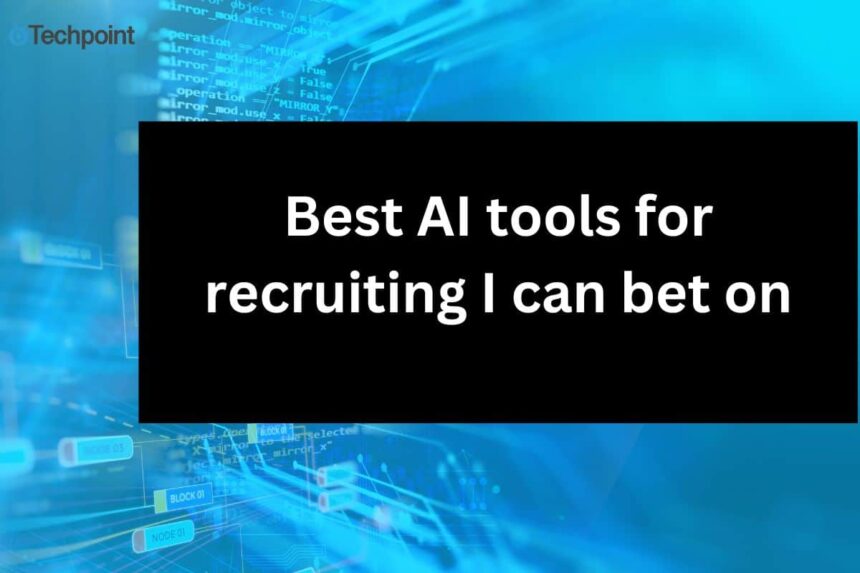Workable
Workable is an AI-powered recruitment platform that offers sourcing, screening, job posting automation, and internal job boards. The platform helps streamline the hiring process by automating tasks like resume screening, interview scheduling, and candidate communication.
Workable also provides AI-driven resume screening, interview kits, and scorecards to help assess candidates efficiently. Additionally, it includes features like career site builders, referral rewards, and collaborative hiring tools for team members to share feedback and evaluate candidates.
Pricing: The starter plan for Workable costs $249 per month.
Key features of Workable:
- Sourcing and screening
- Job posting automation
- Career site builder
- Internal job board & referral rewards
- AI-driven resume screening
- Interview kits & scorecards
- Collaborative hiring tools
4. HireVue

HireVue is a video interviewing platform that uses AI to streamline the interview process. It offers features like interview builder, text transcript evaluation, conversational AI, candidate assessment, and automated scheduling.
The platform allows recruiters to create structured video interviews with pre-set questions and evaluation criteria. It then evaluates candidate responses, providing insights and analysis to help make informed hiring decisions.
Pricing: HireVue’s Essential plan starts at $35,000 per year.
Key features of HireVue:
- Interview builder
- Video interview tool
- Text transcript evaluation
- Conversational AI
- Candidate assessment
- Automated scheduling
- Insights and analysis
5. Manatal

Manatal is an AI-powered recruitment platform that offers candidate sourcing, Applicant Tracking System (ATS), recruitment CRM, candidate enrichment, AI recommendations, reports, and analytics.
The platform helps streamline the recruitment process by automating tasks like resume screening, candidate communication, and interview scheduling. It also provides insights and analytics to help recruiters make data-driven decisions.
Pricing: Manatal starts at $19 per month per user, with a 14-day free trial available.
Key features of Manatal:
- Candidate sourcing
- Applicant Tracking System (ATS)
- Recruitment CRM
- Candidate enrichment
- AI recommendations
- Reports & Analytics
- Collaboration tools
Conclusion
AI is transforming the recruiting process, making it faster, more efficient, and more effective. By using AI tools, recruiters can automate repetitive tasks, gain valuable data insights, reduce bias, and improve the overall candidate experience.
As the job market continues to evolve, incorporating AI into recruitment processes will become essential for staying competitive and finding the best talent. By leveraging AI tools like hireEZ, Eightfold, Workable, HireVue, and Manatal, recruiters can streamline their processes and make more informed hiring decisions.
Remember, while AI tools offer significant benefits, they should always be complemented with human review for the best results. By combining the power of AI with human expertise, recruiters can create a more seamless and effective hiring process for both candidates and companies.
They focus on skills, qualifications, and experience rather than personal characteristics. Additionally, AI tools use algorithms to evaluate candidates based on objective criteria, which helps reduce unconscious bias in the hiring process.
Conclusion
Choosing the best AI recruiting tool for your organization can significantly streamline your hiring process and improve the quality of your hires. Whether you opt for Workable, HireVue, Manatal, or any other tool on the list, make sure to consider your specific needs, budget, and integration requirements before making a decision. With the right AI recruiting tool, you can attract top talent, improve candidate screening and matching, and ultimately build a strong and diverse team.
AI recruiting tools are a valuable asset for small businesses looking to streamline their hiring process. These tools offer a range of features that can help source candidates from diverse backgrounds and make the recruitment process more efficient.
When considering AI recruiting tools for your small business, it’s essential to look for key features that will meet your specific needs. Features like AI-powered candidate matching, automated resume screening, analytics, integration with ATS platforms, and a user-friendly interface are crucial for maximizing the benefits of these tools.
While AI recruiting tools can be a significant investment, it’s essential to assess whether your business truly needs them before committing to a purchase. These tools should be viewed as assistants rather than replacements for human recruiters, as they may have limitations that could impact the quality of candidate evaluations.
To make the most of AI recruiting tools, it’s important to provide high-quality data, including accurate job descriptions, to ensure that the AI can effectively evaluate candidates. Incomplete profiles or missing information could hinder the tool’s ability to match candidates accurately.
In conclusion, AI recruiting tools can be a valuable asset for small businesses, but they should be used with caution and in conjunction with human oversight. By carefully evaluating your needs and providing accurate data, you can maximize the benefits of these tools and streamline your recruitment process effectively. The field of artificial intelligence has seen significant advancements in recent years, with researchers and developers working tirelessly to create intelligent systems that can perform tasks traditionally requiring human intelligence. One of the most exciting developments in the field is the rise of generative AI models, which have the ability to generate new content, such as images, text, and even music, that is indistinguishable from content created by humans.
Generative AI models are based on deep learning algorithms that are trained on vast amounts of data, allowing them to learn patterns and relationships within the data and generate new content that follows similar patterns. These models have been used to create stunningly realistic images, write coherent and engaging text, and even compose music that is indistinguishable from compositions by human musicians.
One of the most popular generative AI models is OpenAI’s GPT-3 (Generative Pre-trained Transformer 3), which has gained widespread attention for its ability to generate human-like text. GPT-3 is a language model that has been trained on a massive dataset of text from the internet, allowing it to generate text that is coherent, fluent, and contextually relevant. The model has been used for a wide range of applications, from writing news articles and blog posts to generating code snippets and answering questions.
Another notable generative AI model is DALL-E, also developed by OpenAI, which is capable of generating images from textual descriptions. DALL-E uses a similar transformer architecture as GPT-3 but has been trained on a dataset of images and their corresponding textual descriptions. The model can generate highly detailed and realistic images based on textual prompts, such as “an armchair in the shape of an avocado” or “a snail made of a stack of pancakes.”
Generative AI models have also been used in the field of music composition, with models like OpenAI’s MuseNet capable of generating music in a wide range of genres and styles. MuseNet has been trained on a dataset of musical compositions and can generate original compositions that sound like they were created by human musicians. The model has been used by musicians and composers to explore new musical ideas and create unique and innovative pieces of music.
While generative AI models have shown great promise in generating realistic and creative content, there are also concerns about the potential misuse of these models. For example, these models could be used to create fake news articles, misleading images, or plagiarized content. There are also ethical concerns about the use of generative AI models in creating content without proper attribution or consent.
Despite these challenges, generative AI models have the potential to revolutionize the way we create and consume content. These models can be used to automate tedious tasks, assist creators in generating new ideas, and even inspire new forms of creativity. As researchers continue to push the boundaries of artificial intelligence, we can expect to see even more exciting developments in the field of generative AI in the years to come.








